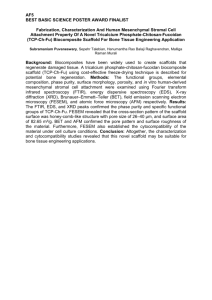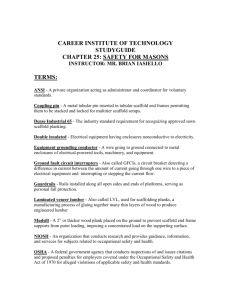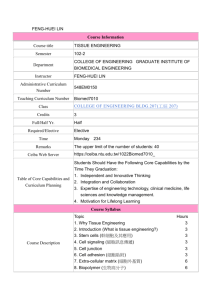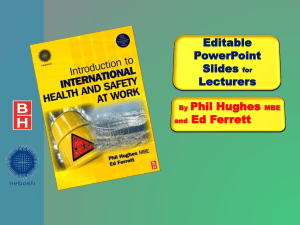TE Triangle-Spec 20
advertisement
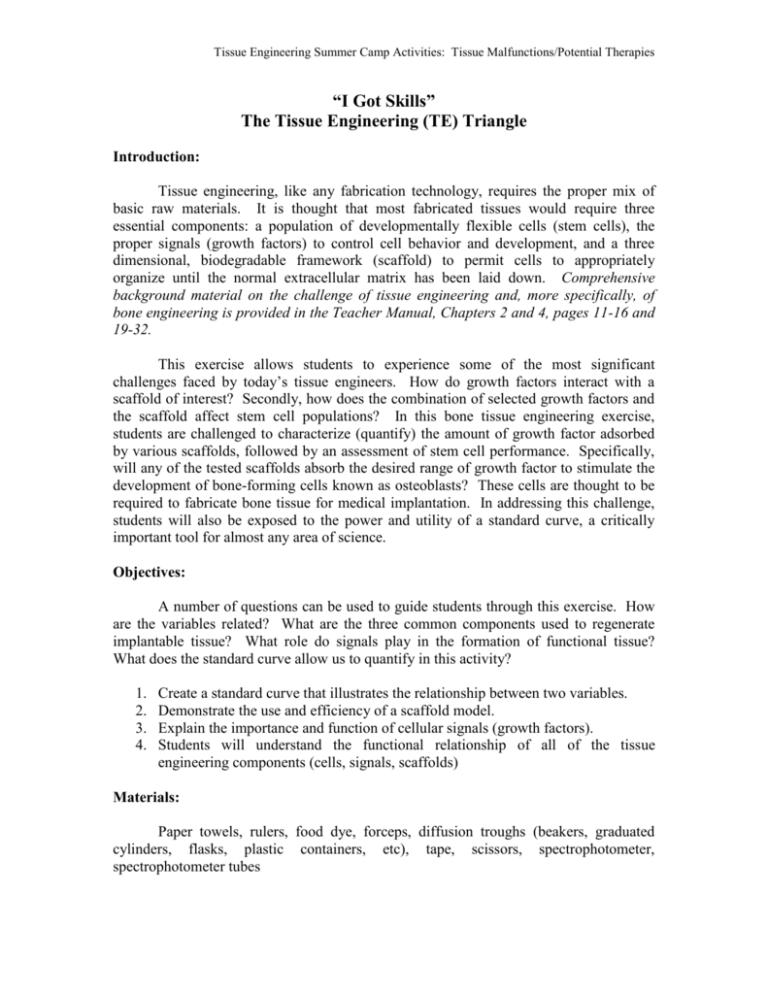
Tissue Engineering Summer Camp Activities: Tissue Malfunctions/Potential Therapies “I Got Skills” The Tissue Engineering (TE) Triangle Introduction: Tissue engineering, like any fabrication technology, requires the proper mix of basic raw materials. It is thought that most fabricated tissues would require three essential components: a population of developmentally flexible cells (stem cells), the proper signals (growth factors) to control cell behavior and development, and a three dimensional, biodegradable framework (scaffold) to permit cells to appropriately organize until the normal extracellular matrix has been laid down. Comprehensive background material on the challenge of tissue engineering and, more specifically, of bone engineering is provided in the Teacher Manual, Chapters 2 and 4, pages 11-16 and 19-32. This exercise allows students to experience some of the most significant challenges faced by today’s tissue engineers. How do growth factors interact with a scaffold of interest? Secondly, how does the combination of selected growth factors and the scaffold affect stem cell populations? In this bone tissue engineering exercise, students are challenged to characterize (quantify) the amount of growth factor adsorbed by various scaffolds, followed by an assessment of stem cell performance. Specifically, will any of the tested scaffolds absorb the desired range of growth factor to stimulate the development of bone-forming cells known as osteoblasts? These cells are thought to be required to fabricate bone tissue for medical implantation. In addressing this challenge, students will also be exposed to the power and utility of a standard curve, a critically important tool for almost any area of science. Objectives: A number of questions can be used to guide students through this exercise. How are the variables related? What are the three common components used to regenerate implantable tissue? What role do signals play in the formation of functional tissue? What does the standard curve allow us to quantify in this activity? 1. 2. 3. 4. Create a standard curve that illustrates the relationship between two variables. Demonstrate the use and efficiency of a scaffold model. Explain the importance and function of cellular signals (growth factors). Students will understand the functional relationship of all of the tissue engineering components (cells, signals, scaffolds) Materials: Paper towels, rulers, food dye, forceps, diffusion troughs (beakers, graduated cylinders, flasks, plastic containers, etc), tape, scissors, spectrophotometer, spectrophotometer tubes Tissue Engineering Summer Camp Activities: Tissue Malfunctions/Potential Therapies Prelude: To reinforce quantification skills, the below-listed, density competition is suggested before performing this exercise. Students are challenged to master pipetting skills and massing skills in attempts to determine the density of a mystery fluid. Procedure: The procedure for the scaffold assay activity is as follows. An overview of the strategies used in this activity can be found in Supplemental Section A of the Teacher Manual, pages 23A-25A. A. Scaffold Diffusion 1. Place the simulated scaffolds (papers) in the diffusion trough. Remove when the dye (simulated growth factor) front reaches the top of one of the scaffolds. Let paper towel pieces hang over a beaker or hold by the straw to avoid touching wet scaffold paper to table or other object (this will avoid leaching problems). 2. Pipette 5 ml. of tap water into each of six culture tubes (spectrophotometer tubes). Steps 1 and 2 can be completed simultaneously by different group members. 3. Cut scaffolds horizontally into three equal sized strips. Transfer strips (avoid touching to a surface) to the culture tubes containing 5 ml. of water. Label tubes accordingly (e.g. scaffold A-top, bottom, middle). 4. Invert tubes gently 10-20 times (be consistent with all tubes). 5. Remove the scaffold paper or tamp to bottom to avoid interference during spec reading. 6. Record the absorbance of each solution. Remember to read absorbance at the appropriate wavelength. For red dye, set to 500. For others, ask instructor. 7. Refer to standard curve. Determine the concentration of growth factor that was imprinted onto each section of the paper scaffolds. 8. Determine the resulting developmental status of stem cells in each section of scaffold by referring to the chart below. Evaluate the relative potential (efficacy) of each scaffold/growth factor construct. [Growth factor] in ppm 0-10 11-20 21-50 51-70 71-100 Cell Developmental Status Mesenchymal (stromal) stem cell Pre-Osteoblast Osteoblast Quiescent Osteocyte Dying cell B. Standard Curve 1. Utilizing the provided stock (100 ppm) of food dye (growth factor) and tap water, generate at least six tubes containing known concentrations of dye. For example, you might wish to create solutions having the following concentrations (in ppm): Tissue Engineering Summer Camp Activities: Tissue Malfunctions/Potential Therapies 0, 10, 20, 30, 50, 70, and 100. It is suggested that most of your concentrations be between 0-50 ppm. The following equation may assist in determining desired concentrations: [ml. of stock/ total ml. of solution] x 100 ppm = [solution]. For example, suppose you add 2 ml. of stock to 3 ml. of tap water. Total volume of solution = 5 ml. Using the equation: [2 ml. / 5 ml.] x 100 ppm = 40 ppm. Recommendation: The culture tubes hold maximum of 10 ml. of fluid; thus it might be easier to mix the solutions if the final volume is in the range of 5-8 ml. 2. Record the absorbance of each solution. 3. Plot a graph of the results. Use a best fit line, i.e., x-axis = concentration, y axis = absorbance. If a spectrophotometer is not available, students can create a color scale for their standard dilutions (1-10, for example). They can then estimate the concentrations of their leached samples by comparing to this set of tubes. This semi-quantitative method is often used in the classroom and in testing kits (such as water analysis or pH). Scaffold Diffusion Assay Standard Curve Tube Number ML of 100 ML of H2O ppm GF Stock Final Concentration of Solution Absorbance Supplemental Activity: Density Competition Step 1: Students will utilize pipettes and micropipettes to measure various volumes of water. The students will dispense the water onto a piece of wax paper so that they may visually compare the different volumes of water. These volumes can be 10 ml, 1ml (1000 ul), 0.1ml (100 ul), 0.01 ml (10 ul). Step 2: 1. Use a small plastic cup to tare the balance (get the display to read 0.000). Do not remove the cup. 2. Using the 10 ml pipette, measure 10 ml of water and dispense it into the tared cup on the scale. 3. Record the mass displayed (in grams). 4. Repeat the procedure, massing the 1ml, 100ul, 10ml, and 1ul volumes of water. 5. Determine density for all of the samples (hint D = M/V) Tissue Engineering Summer Camp Activities: Tissue Malfunctions/Potential Therapies Figure 1: A dilution series of simulated growth factor solution Figure 2: Scaffold seeding growth factor by diffusion Figure 3: Preparing scaffold growth factor leachettes for analysis Figure 4: Quantifying growth factor scaffold seeding by spectrophotometery Tissue Engineering Summer Camp Activities: Tissue Malfunctions/Potential Therapies Teacher Notes: For this lab, we are trying to put the right amount of growth factors on the scaffolds. We used 2 different types of paper towels cut in 1” strips x roughly 5”. We taped them onto a ruler and set up the stock solution to read 100 absorbance. We set up a mystery solution at .38 ppm or 38 nanomolar. Several steps: 1. 2. 3. 4. 5. 6. Discuss reporter molecules Create 8-10 tubes from the stock solution (100 nanomolar) and water (0 nanomolar) to create a standard curve on graph paper. 5 ml of water goes into each. Zero the spec with the water tube. Wavelength was set to 500. Stock solution absorbance was set to 100 absorbance Dip the scaffolds in the 100 nanomolar solution. Cut the 2 of them in half and place them in 4 separate tubes invert them 20 times each, pull out the scaffold and determine the growth factor that leached out of the scaffold. Draw the 4 lines on the graph-2 from the bottom cuts and 2 from the top cuts Use the spectrophotometer and determine the nanomolar concentration of the mystery solution. Osteoblasts build bone—good for TE Osteoclasts break down bone-bad for TE


